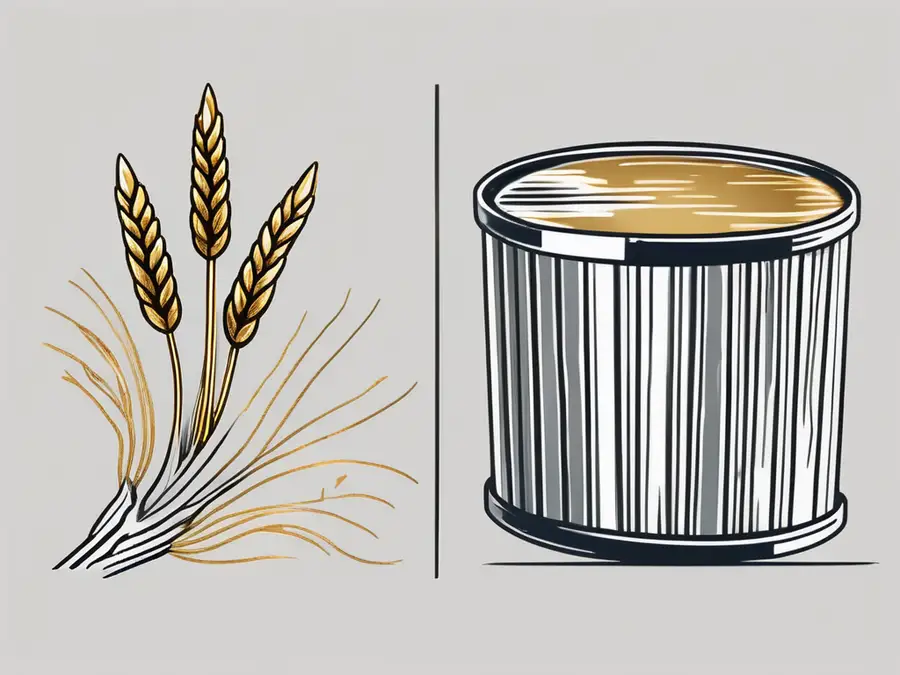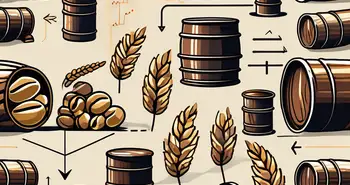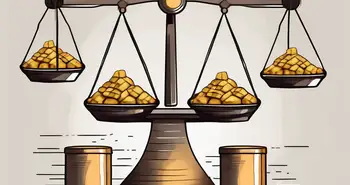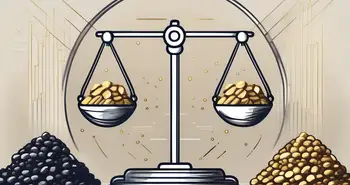Commodity vs Asset: Understanding the Key Differences

Commodities and assets are two terms that are often used interchangeably, but they represent distinct concepts in the world of finance and investing. In this article, we will explore the differences between the two and shed light on their unique characteristics. By the end, you will have a clearer understanding of what sets commodities and assets apart, and how they can impact your investment strategy.
Defining the Basics: What are Commodities?
Commodities are raw materials or primary agricultural products that can be bought and sold in standardized quantities. These include tangible goods such as natural resources (oil, gas, metals), agricultural products (wheat, corn, coffee), and even livestock. Commodities form the building blocks of various industries and are traded on dedicated exchanges around the world.
When investing in commodities, it's important to understand their nature. Commodities are generally fungible and interchangeable, meaning that one unit of a particular commodity is the same as any other unit of that commodity. This standardization makes it easier to trade them on exchanges and establishes a benchmark price for each commodity.
The Nature of Commodities
Commodities possess intrinsic value because they are the fundamental inputs of goods and services. For example, oil is essential for energy production, and gold is widely used in jewelry and as a store of value. As a result, commodity prices are influenced by factors such as supply and demand dynamics, geopolitical events, and global economic conditions.
Types of Commodities
Commodities are typically categorized into four main groups: energy, metals, agriculture, and livestock. Each group has its own unique characteristics and factors that can impact its pricing. Energy commodities include products such as crude oil, natural gas, and gasoline. Metal commodities consist of precious metals like gold and silver, as well as base metals like copper and aluminum. Agriculture commodities encompass crops like wheat, corn, and soybeans, while livestock commodities include the trading of animals such as cattle and hogs.
Trading and Investing in Commodities
There are several ways to invest in commodities, each with its own advantages and considerations. One common method is through futures contracts, where investors agree to buy or sell a commodity at a predetermined price and date in the future. Another method is through exchange-traded funds (ETFs), which provide diversified exposure to a basket of commodities. Additionally, some investors directly purchase physical commodities, such as gold bars or oil barrels, for storage and potential appreciation.
As an expert in commodities, I have personally witnessed the impact of supply disruptions on commodity prices. For example, a drought affecting major grain-producing regions can significantly impact the price of wheat or corn. Understanding these external factors is crucial when trading and investing in commodities.
Breaking Down Assets: An Overview
Assets, on the other hand, encompass a broader range of financial instruments and properties. In simple terms, an asset is anything of value that an individual or entity owns and can derive economic benefit from. Assets can be divided into various categories, including cash, stocks, bonds, real estate, and even intellectual property.
Understanding Different Types of Assets
Assets can be classified into two main categories: tangible and intangible. Tangible assets are physical assets that have a physical form and can be touched, such as real estate or machinery. Intangible assets, on the other hand, do not have a physical presence and include assets like patents, trademarks, and intellectual property.
The Role of Assets in Investment
Assets play a vital role in investment portfolios, as they provide potential returns and diversification benefits. Stocks and bonds, for example, are popular asset classes that offer investors the opportunity to participate in the growth of companies and governments. Real estate and precious metals like gold are often considered alternative assets that can act as hedges against inflation or provide stability in times of market uncertainty.
How Assets are Valued
Valuing assets can be a complex process that depends on various factors. For publicly traded assets, the market determines their value through supply and demand dynamics. Private assets, such as real estate or privately held businesses, may require more extensive analysis to determine their worth. Valuation methods for assets can include comparing similar assets, income or cash flow-based approaches, and considering the prevailing economic conditions.
Key Differences Between Commodities and Assets
Now that we have explored the fundamentals of commodities and assets, let's delve into the key differences between the two.
Value Determination: Commodities vs Assets
Commodity prices are predominantly driven by supply and demand factors, which can fluctuate rapidly based on global economic conditions and geopolitical events. Asset values, on the other hand, are influenced by various factors unique to each asset class. For instance, stock prices can be influenced by company earnings, market sentiment, and overall economic performance, whereas real estate values are influenced by location, demand, and interest rates.
Risk Factors in Commodities and Assets
Commodities are subjected to inherent risks associated with their production, supply chain disruptions, and geopolitical uncertainties. Natural disasters, political instability, and market speculation can all impact commodity prices. Assets, particularly financial assets like stocks and bonds, are exposed to a different set of risks, including market volatility, company-specific risks, and interest rate fluctuations. The risk exposure of commodities and assets can vary significantly, making diversification an important consideration for investors.
Liquidity and Marketability: A Comparative Analysis
Commodities, being traded on dedicated exchanges, tend to have high liquidity and marketability. This means that investors can easily buy and sell commodities on the open market without significant price variations. Assets, especially those with limited trading volumes or held in illiquid markets, may present challenges when trying to exit positions or realize the full value of the asset.
The Impact of Economic Factors on Commodities and Assets
The prices of both commodities and assets are profoundly influenced by various economic factors. Let's take a closer look at some of the key economic drivers in each category.
Influence of Inflation and Deflation
Inflation and deflation have contrasting impacts on commodities and assets. Commodities, particularly precious metals like gold, are often seen as a hedge against inflation. When the general price level rises, the value of commodities may increase, as people seek to preserve their purchasing power. Assets, on the other hand, tend to benefit from a low inflation environment, as stable prices and low interest rates can support economic growth and investor confidence.
The Role of Supply and Demand
Supply and demand dynamics are critical drivers of both commodity and asset prices. Commodity prices respond to changes in supply and demand, which can be influenced by factors such as weather conditions, geopolitical tensions, and changes in industrial demand. Asset prices, including stocks and real estate, are also influenced by supply and demand factors, but these can be more nuanced. For example, changes in interest rates can affect the demand for housing and impact real estate prices.
Economic Cycles and Their Effects
Economic cycles, characterized by periods of expansion and contraction, can have varying effects on commodities and assets. During periods of economic growth, commodities like oil and industrial metals tend to perform well due to increased demand for raw materials. Assets such as stocks and real estate also tend to benefit from a growing economy. However, during economic downturns, commodities may experience a decline in demand, while assets can be significantly affected by market volatility and decreasing investor confidence.
FAQ (Frequently Asked Questions)
What are the main differences between commodities and assets?
Commodities are raw materials or primary agricultural products that are traded on exchanges, while assets encompass a broader range of financial instruments and properties. Commodities have value based on their intrinsic use, while the value of assets is derived from factors specific to each asset class.
How can I invest in commodities?
There are several ways to invest in commodities, including through futures contracts, exchange-traded funds (ETFs), and purchasing physical commodities. Each method has its own considerations and risk factors.
What is the role of assets in an investment portfolio?
Assets play a crucial role in diversifying an investment portfolio and can provide potential returns and stability. Different asset classes, such as stocks, bonds, and real estate, offer investors various opportunities for growth and income generation.
How are commodity prices determined?
Commodity prices are primarily determined by supply and demand dynamics. Factors such as geopolitical events, global economic conditions, and natural disasters can all affect commodity prices.
Which economic factors influence commodities and assets?
Inflation and deflation, supply and demand dynamics, and economic cycles are some of the key economic factors that influence both commodities and assets. However, the impact and responses can vary between the two.
Understanding the differences between commodities and assets can empower you as an investor to make informed decisions and build a well-diversified portfolio. Whether you choose to invest in commodities for their intrinsic value or assets for their potential returns, considering the unique characteristics and risks involved is essential. By balancing your investment strategy and staying attuned to economic forces, you can navigate the ever-changing landscape of financial markets with confidence.
Ready to take your investment strategy to the next level with the unique advantages of commodities and assets? Look no further than Morpher, the revolutionary trading platform that harnesses blockchain technology to offer zero fees, infinite liquidity, and fractional investing across a diverse range of markets. With Morpher, you can effortlessly diversify your portfolio, trade with up to 10x leverage, and enjoy the safety of a non-custodial wallet. Experience the future of trading with Virtual Futures and a platform that's as innovative as your investment approach. Sign Up and Get Your Free Sign Up Bonus today to transform the way you trade!

Disclaimer: All investments involve risk, and the past performance of a security, industry, sector, market, financial product, trading strategy, or individual’s trading does not guarantee future results or returns. Investors are fully responsible for any investment decisions they make. Such decisions should be based solely on an evaluation of their financial circumstances, investment objectives, risk tolerance, and liquidity needs. This post does not constitute investment advice.

Painless trading for everyone
Hundreds of markets all in one place - Apple, Bitcoin, Gold, Watches, NFTs, Sneakers and so much more.

Painless trading for everyone
Hundreds of markets all in one place - Apple, Bitcoin, Gold, Watches, NFTs, Sneakers and so much more.









